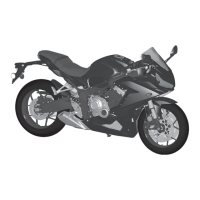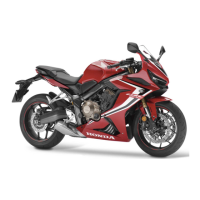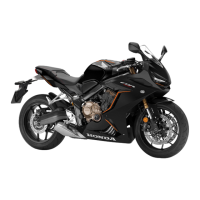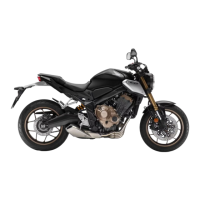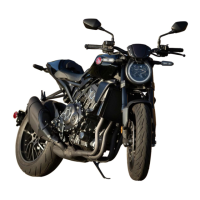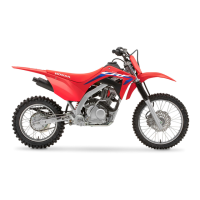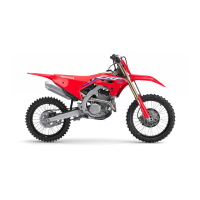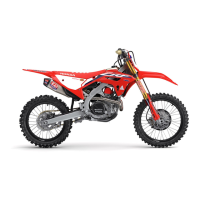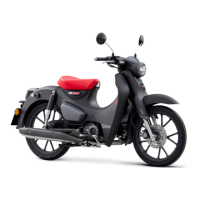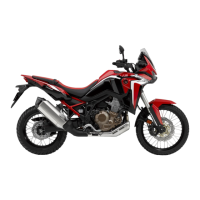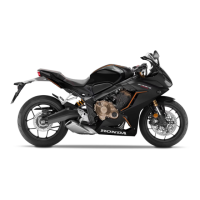
Do you have a question about the Honda CBR650R 2022 and is the answer not in the manual?
| Bore x Stroke | 67.0 mm x 46.0 mm |
|---|---|
| Compression Ratio | 11.6:1 |
| Fuel System | PGM-FI electronic fuel injection |
| Transmission | 6-speed |
| Front Tire | 120/70ZR17 |
| Rear Tire | 180/55ZR17 |
| Seat Height | 31.9 inches |
| Fuel Capacity | 4.1 gallons |
| Max Power | 94 hp @ 12, 000 rpm |
| Final Drive | Chain |
| Engine Type | Liquid-cooled, 4-stroke, DOHC, 4-cylinder |
| Front Suspension | 41mm |
| Rear Suspension | Single shock with adjustable preload |
| Front Brakes | Dual 310 mm discs with 4-piston calipers |
| Rear Brakes | Single 240mm disc with single-piston caliper |
| Ignition | Transistorized |
Provides guidelines to enhance rider safety, including routine inspections, fuel handling, and engine operation in enclosed areas.
Explains the purpose of safety and information labels on the vehicle that warn of potential hazards.
Details precautions for safe riding, including rider positioning, passenger safety, and protective apparel requirements.
Covers essential riding precautions such as break-in period, brake usage, and riding in various conditions.
Advises against adding unauthorized accessories or making modifications that could compromise safety.
Provides guidelines on carrying extra weight, emphasizing safe speed, load limits, and secure luggage balancing.
Identifies and illustrates the location of major vehicle components and controls for easy reference.
Details the motorcycle's instrument panel, including display checks, various displays, and setting modes.
Explains the function and meaning of various indicator lights on the instrument panel.
Describes the location and function of all switches and controls on the motorcycle.
Provides a step-by-step procedure for starting the engine, including important notices.
Explains the 6-speed transmission and provides recommended shift points for optimal performance.
Details the procedure for opening and closing the fuel filler cap, along with fuel type and capacity information.
Describes the location and use of the helmet holder, tool kit, document bag, and luggage tie-down hooks.
Stresses the essential role of proper maintenance for safety, performance, and vehicle longevity.
Provides a log for recording maintenance performed, including distance, date, and who performed the service.
Outlines the recommended periodic maintenance tasks and their required frequencies for optimal vehicle condition.
Covers essential maintenance practices, including pre-ride inspections and safety guidelines.
Details the maintenance-free battery, including cleaning terminals, charging, and emergency procedures.
Explains the procedure for removing and installing the front seat of the vehicle.
Provides instructions for removing and installing the rear seat, including seat lock operation.
Covers checking and adding engine oil, including selecting the correct oil type and capacity.
Details how to check and add coolant, including reserve tank levels and recommended coolant types.
Explains how to check brake fluid levels and inspect brake pads for wear.
Describes how to check the operation and condition of the vehicle's side stand.
Covers inspecting the drive chain slack, cleaning, and lubricating the chain for optimal performance.
Details how to check and adjust the clutch lever freeplay for proper operation.
Explains how to check and adjust the throttle grip freeplay for smooth operation.
Covers adjustments for the brake lever and rear suspension preload.
Provides troubleshooting steps for when the engine does not start or the starter motor operates but the engine fails to run.
Explains how to diagnose and address engine overheating issues indicated by the coolant temperature gauge.
Details potential issues indicated by warning lights such as low oil pressure, PGM-FI, ABS, and Torque Control.
Covers indications of fuel gauge and coolant temperature gauge failures.
Provides guidance on emergency tire repair and the risks associated with temporary repairs.
Addresses common electrical issues like dead batteries, burned-out bulbs, and blown fuses.
Describes the ignition keys, key tag, and procedures for making duplicate keys.
Explains ignition switch, engine stop switch, odometer, tripmeter, document bag, and other features.
Provides guidance on washing, polishing, and protecting the vehicle's components.
Offers advice on preparing the vehicle for extended storage, including cleaning and battery care.
Details safe procedures for transporting the motorcycle using trailers or flatbed trucks.
Promotes environmental responsibility through sensible cleaning and waste recycling practices.
Explains the VIN and engine serial number, crucial for registration and parts ordering.
Describes exhaust, noise, and evaporative emission control systems and their requirements.
Explains the function of the catalytic converter and guidelines to protect it from damage.
Discusses the use of oxygenated fuels, approved blends, and potential issues.
Lists available Honda manuals, including service and storage guides, and how to order them.
Outlines warranty coverage, service recommendations, and handling of potential issues.
Provides contact information for American Honda Motor Co., Inc. and Honda Canada Inc.
Guides on how to report vehicle safety defects to NHTSA and Transport Canada.
Lists key specifications for the vehicle's main components, including dimensions and weight.
Provides detailed service data, including tire specifications, fluid capacities, and recommended lubricants.
